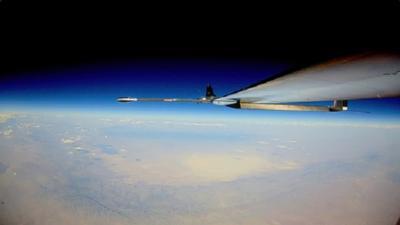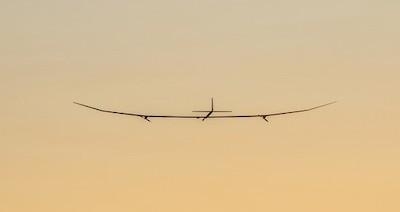BAE Systems' Pseudo Satellite Soars Over New Mexico
Engineers have completed a successful stratospheric flight trial of BAE Systems’ High Altitude Pseudo Satellite (HAPS) Uncrewed Aerial System (UAS).

Dubbed PHASA-35, the UAS soared, over a 24-hour period, to an altitude of more than 66,000-feet MSL before landing safely. The flight-testing campaign was undertaken in New Mexico, and allowed engineers to assess the experimental solar-electric drone’s performance within the outer-reaches of the Earth’s atmosphere.
The test-flight occasioned a milestone in PHASA-35’s development, which has thus far spanned six-years. Designed by BAE subsidiary Prismatic Ltd. to operate above most of the planet’s weather and the entirety of its conventional air-traffic, PHASA-35 constitutes an alternative to traditional airborne and satellite systems and represents a potential persistent and stable platform for endeavors the likes of ultra-long-endurance Intelligence, Surveillance, and Reconnaissance (ISR) and security missions. The vehicle’s possible applications extend to the delivery of communications networks, including 4G and 5G, disaster relief, maritime patrol, and border protection.
The PHASA-35 program falls under the auspices of BAE’s FalconWorks division, an intra-company enclave tasked with advanced and agile research and development within BAE Systems’ Air sector. Analogous to Lockheed-Martin’s celebrated Skunk Works, FalconWorks aspires to deliver a range of bleeding-edge combat air-capabilities to the U.K. and its allies.
Comprising primarily advanced composites and sporting a 115-foot (35-meter) wingspan, PHASA-35 is powered, during daylight hours, by solar-electric cells and photo-voltaic arrays. Electrical energy derived of sunlight is stored in rechargeable batteries which power the UAS during periods of darkness.
The New Mexico flight-test afforded BAE engineers opportunity to assess the experimental UAS’s performance across a range of variables, and was the first in a series of trials intended to validate PHASA-35’s fitness for international commercial and defense applications.
Prismatic CEO Dave Corfield stated: “This is a fantastic achievement for everyone involved and shows the commitment of BAE Systems to invest in new technologies and markets. PHASA-35’s first stratospheric flight demonstrates that this vehicle is on track to become the go-to system for long endurance, high altitude and communications applications in the future.
Mr. Corfield continued: “The successful trials are a testament to the hard work of the fantastic team that we have built over the last couple of years within Prismatic and across our partner companies including Piran, Amprius, Microlink, Honeywell, PMW Dynamics, and the Met Office. I look forward to the next steps as we develop this unique system.”

BAE Systems’ Air Sector group managing director Cliff Robson set forth: “PHASA-35 is breaking new ground—opening up the stratosphere to new possibilities. The team, which brings together BAE Systems’ know-how from across the globe with innovative solar and power management technologies, demonstrated tremendous commitment and ambition as they tackled the challenges associated with novel technologies and approaches. This partnership approach is key to our ability to enhance our defense expertise with new thinking and technologies.”
The PHASA-35 flight-test program was based at New Mexico’s Spaceport America facility and flown in the United States Army’s White Sands Missile Range. The undertaking was sponsored by the U.S. Army Space and Missile Defense Command Technical Center. The test-flight was coordinated and directly supported by personnel attached to Naval Surface Warfare Center, Port Hueneme Division, Detachment White Sands.
 ANN's Daily Aero-Term (05.17.24): Very High Frequency
ANN's Daily Aero-Term (05.17.24): Very High Frequency ANN's Daily Aero-Linx (05.17.24)
ANN's Daily Aero-Linx (05.17.24) ANN FAQ: Submit a News Story!
ANN FAQ: Submit a News Story! Classic Aero-TV: ANN Visits Wings Over The Rockies Exploration Of Flight
Classic Aero-TV: ANN Visits Wings Over The Rockies Exploration Of Flight Airborne Affordable Flyers 05.16.24: PRA Runway, Wag-Aero Sold, Young Eagles
Airborne Affordable Flyers 05.16.24: PRA Runway, Wag-Aero Sold, Young Eagles




